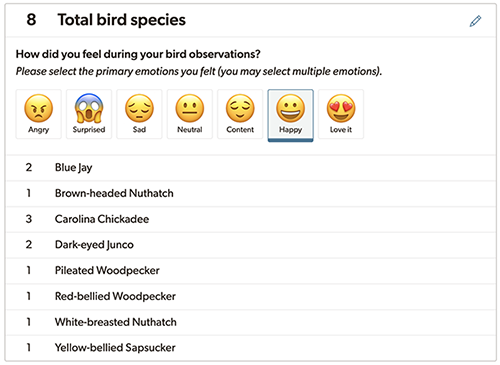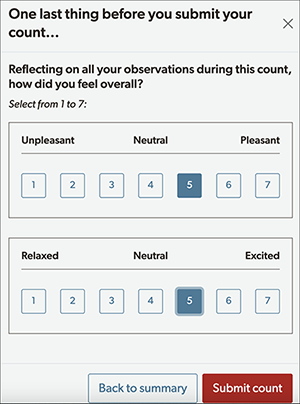
[ad_1]
November 27, 2023
Project FeederWatch adds the option to submit data on your emotions to study human-bird relationships.
By Christy Pototsky, Virginia Tech

This season 80% of Project FeederWatch participants are participating in new optional aspects of Project FeederWatch data collection. Along with recording types of mammals seen during a count, specific signs of disease in birds, bird mortality during counts, management activities conducted at a site, participants can now report on the emotions they experience while observing birds. These changes make Project FeederWatch one of the first participatory science projects to bring together social (human) and ecological (bird) data. Reporting on emotional data is rare in participatory science, especially in the context of bird observation, so let’s talk about what this kind of information can tell us. First, a question to kick off our conversation:
What is your most memorable experience of wildlife?
Perhaps it was the first time you saw a clutch of eggs in a nest box. Or perhaps you witnessed a battle between a bald eagle and an osprey. Or a black bear “visiting” your bird feeders!
Think about your memorable moment and how you responded. Do words like excitement, surprise, happiness, sadness, anger, or fear come to mind? The answer to this question is probably “yes,” because it is these kinds of emotional reactions that steep our everyday experiences with meaning. Emotions play a critical role in memory and are probably the most basic human response to animals.
From an evolutionary perspective, emotions help us react to our environment and improve our chances of survival. Because of this mechanism, humans have a strong predisposition to react emotionally to animals. For example, when we see a bear, we feel afraid and our bodies prepare for ‘fight-or-flight’—our hearts start pounding and we breathe more rapidly. Not only does emotion influence how we interpret experiences with wildlife, but it also can change our behavior. In our brain, emotions interact with our thoughts to help us make decisions. So, once we feel fear in response to a bear, we might choose to back away rather than move closer. Thank goodness for emotion!
Beyond a single moment in time, the quality (negative to positive) and intensity (low to high) of an emotion indicates the presence of an experience that may have an impact—positive or negative, strong or weak—on our overall well-being. With all these processes in mind, if we want to better understand relationships between humans and birds, it is important to consider the role of emotion.

Scientists have systematically studied emotions for a long time. In fact, Charles Darwin published his book The Expression of the Emotions in Man and Animals in 1872! Just like animal behavior, components of human behavior, like emotion, can be studied scientifically. Luckily, we can even directly ask other human beings about these components. That is where FeederWatchers come in!

In the updated Project FeederWatch data entry system, participants can now report on the emotions they experience while observing birds and other animals at their count site. If participants opt into reporting emotions, they can click on one or more of the emoticons listed in each section of their count summary (total bird species, symptoms of disease reported, bird deaths reported, total behavioral interactions), ranging from angry to surprised to neutral to happy. Participants are also asked about the overall quality (unpleasant to pleasant) and intensity (relaxed to excited) of their emotional experience during their count.
Reporting these emotions are optional, but we hope FeederWatchers will enjoy the experience of a new kind of data collection! We also hope that this research can be used to support the well-being of birds and people!
<< Return to blog home
[ad_2]






